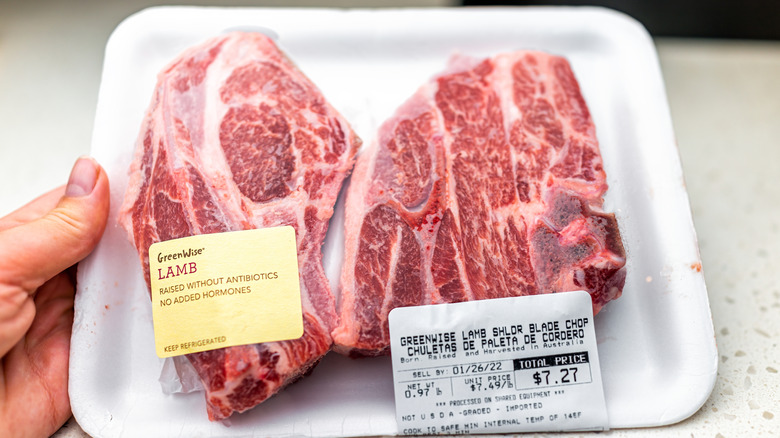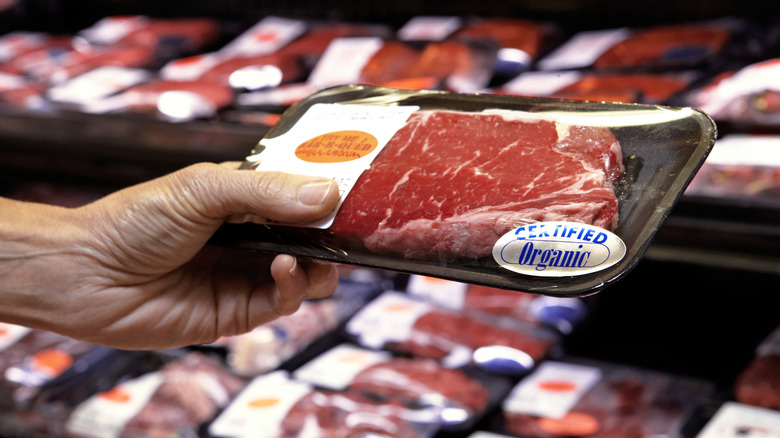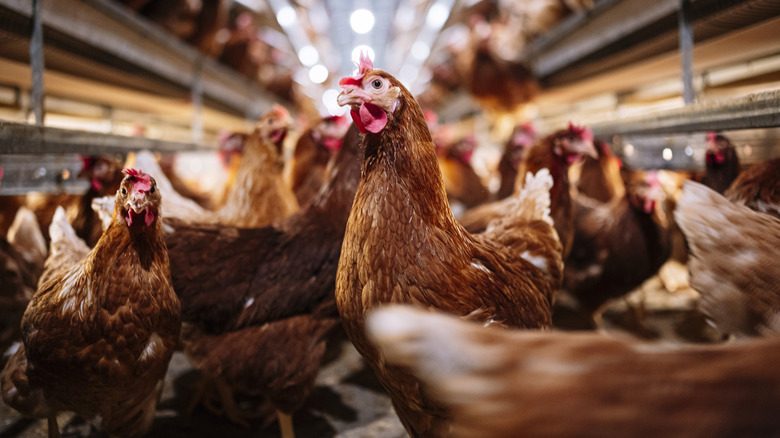What Does It Mean When Meat And Poultry Have A 'No Antibiotics' Labels?
If you're looking for the best cuts of beef or poultry at your local grocery store, you've probably noticed that some feature "no antibiotics" labels. While many people will automatically grab meat labeled like that, thinking it's healthier, most don't actually know what the labels mean and why they can be somewhat misleading. According to the United States Department of Agriculture (USDA), meat and poultry can only be labeled "no antibiotics added" if documents prove that the animals were raised without the drugs from birth til slaughter. But according to Healthline, this isn't always the case.
For example, a Science study released in 2022 noted that the USDA doesn't require testing to demonstrate the absence of antibiotics, and the researchers subsequently discovered that 42% of tested samples labeled "raised without antibiotics" contained the drugs. In response to pushback, the USDA stated it would begin implementing stricter assessments and third-party verification. Still, Consumer Reports has deemed the current verification process "poor," explaining that although companies must submit a copy of their labels to be approved, verification requirements are "weak," and the process is "not consistent across different foods."
While labels like "no antibiotics" or "raised without antibiotics" might not always be truthful, there is a way you can verify the claims. Look for meat and poultry brands that state they're "USDA Process Verified" and feature the executive department's shield. Products bearing this label are required to be inspected by the USDA to verify they're not using any antibiotics.
Making sense of labels is important for consumers
Meat producers use many different terms on their labels that seem designed to confuse or mislead customers. Case in point: People are still unsure of what "organic" truly means when it comes to food. If you see this label on meat, it means that no antibiotics were used, save for some given to poultry immediately after being hatched. If an animal falls ill and requires antibiotics, it can no longer be slaughtered and sold as organic.
However, if the label reads "raised without antibiotics," the animals should not have been given any throughout their lives. That said, it's still best to look for the USDA Process Verified stamp of approval to ensure inspections back up these claims. Another label to keep in mind is any proclaiming no growth hormones were used. In 2017, the FDA prohibited the use of antibiotics in livestock to speed up growth. However, this doesn't mean none are ever used. In fact, antibiotics such as tylosin, which does induce growth, can still be used under the premise of preventing disease.
Along with meat at stores, restaurants also should be considered. According to Consumer Reports, some like Chick-Fil-A and Panera Bread use meats largely raised without antibiotics. However, Chick-Fil-A changed its policy alongside Tyson and Pilgrim's Pride due supply chain shortages, which wasn't helped by the 2022 bird flu outbreak that devastated many commercial flocks. Similarly, Panarea states some of its turkey doesn't meet its own animal welfare standards due to the disease. Although outbreaks of illnesses among livestock can leave distributors with few choices, the dangers of antibiotics in meat and poultry are still important to consider.
Why antibiotics in meat and poultry is a health risk
The reason why antibiotics in meat and poultry can be dangerous is because they can directly harm human health. This is why in 2022, the European Union banned the use of the drugs in animal feed. The problem is that when they're regularly administered to animals, the process can drive the growth of antibiotic-resistant bacteria, making treatment potentially ineffective in the future if they spread. Because of this, in 2017, the World Health Organization urged farmers to stop using antibiotics on healthy animals, citing the misuse of the drugs as a contributor to the rise of resistant bacteria strains.
According to the CDC, over 2.8 million Americans experience antibiotic-resistant infections every year, and this number is rising to become a global public health threat. Although the overuse of antibiotics in humans is one contributing factor, the use in livestock also plays a significant role. The CDC advises livestock and poultry producers to only use antibiotics when necessary. However, because the drugs are still allowed in meat, they continue to fuel the rise in resistant bacteria. Although Healthline states the amount of antibiotics in meat and poultry is low, it also explains that resistant bacteria that develop in animals can spread to humans. The outlet cites a 2011 FDA report that found resistant bacteria in different types of meat in U.S. grocery stores.
Ultimately, the overuse of antibiotics in livestock has contributed to a more significant overall problem that's unlikely to change quickly. But it's not all doom and gloom. By selecting meat and poultry that's antibiotic-free, you can have more control over what you're consuming and avoid potential health risks.


